100th Anniversary Great Nave Tour at the Cathedral of St. John the Divine
Celebrate the 1925 construction of the stunning nave inside the world's largest Gothic cathedral!



Battery Park City is one of Manhattan’s newest neighborhoods. Construction began in the late 1970s. The planned community at the southwest tip of Manhattan took its name from the Battery, a public park to the south which faces New York Harbor. With a third of the neighborhood occupied by parkland, it is seen by many as a quiet escape from the fast-paced stress of the Financial District. Many of the neighborhood’s buildings are just a decade or two old, especially those rebuilt following 9/11. Here are the top 12 secrets of Battery Park City!

Before Battery Park City housed the tall, modern buildings it does today, much of the land was temporarily a wheat field as part of an art installation. In 1982, artist Agnes Denes planted two acres of wheat on the newly formed land as part of a piece called Wheatfield — A Confrontation. The installation, which was sponsored by the Public Art Fund, brought attention to the abandoned and empty locations along the city’s waterfront. Around 285 furrows were dug by hand, each of which took over two hours. It took months to install a proper irrigation system and clear out rocks.
Ultimately, in August of that year, Denes harvested over 1,000 pounds of golden wheat as a commentary on the ecological crisis. Denes at the time described the piece as a “symbol, a universal concept. It represents food, energy, commerce, world trade, and economics. It refers to mismanagement and world hunger. It is an intrusion into the Citadel, a confrontation of High Civilization. Then again, it is also Shangri-La, a small paradise, one’s childhood, a hot summer afternoon in the country, peace. Forgotten values, simple pleasures.” Despite the success of the project, Denes remained in relative obscurity. Her work appeared in NYC again when her piece “The Living Pyramid,” a grassy ziggurat, appeared in 2015 at Socrates Sculpture Park.

Around the 1950s, downtown Manhattan had lost much of its shipping industry to Port Elizabeth, which freed up waterfront land for other developments. In 1968, the Battery Park City Authority was created to revitalize the area. The Authority settled on a proposal to construct a new neighborhood on top of landfill. This material was taken from the World Trade Center‘s construction nearby. After the area’s many abandoned piers were removed, the space was filled with sand and then covered with landfill.
The landfill was completed by 1976, with construction efforts paused amid the city’s 1977 financial crisis. Before construction began on the neighborhood’s first residential building in 1980, an anti-nuclear power rally was held at the site. This rally in September 1979 drew a crowd of nearly 200,000 and was the largest anti-nuke rally in the city at that point in time. That record was broken by a rally in Central Park in 1982 that drew an estimated 1 million protesters. The 6-hour Battery Park rally occurred after four nights of benefit concerts at Madison Square Garden featuring acts like Bruce Springsteen, Jackson Browne, and Grahm Nash – founding members of Musicians United For Safe Energy (MUSE), an organization that formed after the Three Mile Island disaster. Construction on the World Financial Center, as well as hundreds of residential units, began in 1981.

Just to the east of present-day Battery Park City, developers in the 1920s proposed a residential development called Battery Tower. The tower would have been the first completed hotel-apartment in the area and one of the tallest buildings in New York City. At the time, the Battery Park area was predominantly wealthy, with many colonial buildings and some tenements. The tower would have been an architectural feat for the neighborhood, offering 428 suites and 255 bachelor rooms. It would have stood 435 feet high, built entirely of brick and steel, and would have featured six floors for offices and shops. The building also would have had terraces facing the Hudson River and would have featured all sorts of luxury amenities.
A company called Downtown Homes, Inc. began construction on the building with a budget of $10 million in 1929. Over the course of a month, a number of four-story apartments were demolished to make way for the Battery Tower, with foundations installed a year earlier. However, the construction process was very difficult, given the many remnants of sunken docks and ships in the bedrock. Ultimately, the project was left unfinished, and about five decades later, construction on Battery Park City began where the tower would have stood.



Battery Park houses a number of innovative memorials to those who lost their lives in events including the Irish Potato Famine, 9/11, and Hurricane Maria. The Irish Hunger Memorial on Vesey Street and North End Avenue was created to raise awareness of a catastrophic event that greatly increased Irish immigration to the United States in the 1840s and 1850s. Between 1845 and 1852, over a million Irish people starved to death due to a potato blight, leading over 900,000 to relocate to New York.
Designed by artist Brian Tolle and landscape architect Gail Wittwer-Laird, the memorial stretches over half an acre. To create a pastoral landscape, Tolle and Wittwer-Laird used over 60 native plants from Ireland and stones from each one of the island’s 32 counties. There are also remnants of a 19th-century cottage that were transported from the Emerald Isle to Battery Park City. The cottage was donated by the Slacks of Attymass in County Mayo.

The Museum of Jewish Heritage in Battery Park City serves as a living memorial to those who lost their lives in the Holocaust. Designed as a six-sided building with a pyramidal roof, this shape represents the six million Jewish lives lost. The $21.5 million museum was built between 1994 and 1997, though plans for the museum go back decades. Jewish groups proposed the creation of a museum shortly after the end of the Holocaust, and there were even efforts by President Jimmy Carter to put the National Holocaust Memorial in New York City.
Ultimately, the museum was slated for the U.S. Custom House, though it was relocated to Battery Park City nearly a decade before its construction. The museum merged with Brooklyn’s Center for Holocaust Studies and was fully completed in 1997, with an additional wing named for lawyer Robert Morgenthau. Over the years, the museum has put on a core exhibition including the sections Jewish Life A Century Ago, The War Against the Jews, and Jewish Renewal, installations such as a Holocaust-era train car and a stone garden, and an exhibition showcasing Holocaust-era art.





Artist Tom Otterness‘ public sculpture installation The Real World features everything from faces on the ground to cute animals and mini characters seemingly in a state of war. Otterness is known for his playful yet political and cartoonish figures, which are found throughout New York. Otterness often riffs on capitalism, featuring bankers with money bags for heads, workers holding hammers, and other whimsical figures.
The Real World is a collection of sculptures in Rockefeller Park featuring bronze characters in unexpected places, some ready to pounce on passersby, others mischievously fighting. Sculptures range from a monkey in a top hat grasping its young, two rather amorphous feet, a tilted house with money falling from the side, and little characters playing with chess pieces. In one particularly surprising sculpture, a cat is tied to a wooden board that is carried by other animals. In another, a dog is forever tied to a pole, which was in part inspired by one of his early, very controversial, videos in which he shot a dog.

Between the 1880s and 1940s, the area that would become Battery Park City was known as Little Syria. The neighborhood stretched more or less from Washington Street to Rector Street and was a haven for immigrants from Syria, Lebanon, Jordan, and Palestine, though there were also large populations of German, Irish, and Scandinavian families as well. Among the first residents of the area were Syrian Christians, though many only stayed for a few years. Following the 1860 Syrian Civil War, many Syrian Christians came alongside a small Druze community, many working as peddlers selling all sorts of goods. Jeweler Marie el-Khoury achieved great success in the neighborhood before relocating to Atlantic City.
The community continued to grow, opening new religious institutions, but anti-Arab sentiment grew strongly in the late 1800s. Though the area had just a few thousand Arab residents, many newspapers attacked them for their customs. Many lived in small multi-family tenements, though the more wealthy residents eventually moved to Bay Ridge or Atlantic Avenue to start new communities. Despite major discrimination, many famous writers settled in the neighborhood, including Lebanese author Khalil Gibran, and established some of the first Arabic-language periodicals. The neighborhood was ultimately destroyed when construction began on entrance ramps to the Brooklyn-Battery Tunnel, and very few remnants of the neighborhood still exist.


South Cove, near the southern end of Battery Park City, is designed to pay homage to the area’s maritime history. Completed in 1987, the design of South Cove was a collaboration between the architects Susan Child and Douglas Reed of Child Associates, Stan Eckstut of Cooper Robertson Eckstut, and environmental artist Mary Miss. Spread across 3.5 acres, the multi-level site features a forested hillside planted with honey locusts and other plants that occur naturally on the Northeastern seaside, a waterfront esplanade, and a cast iron lookout with a curving shape meant to evoke the crown of the Statue of Liberty which can be viewed from the lookout. Placed atop a row of wooden lampposts are a series of blue ship’s lights that harken to Battery Park City’s history as a bustling port.

Near the Museum of Jewish Heritage, Robert F. Wagner Jr. Park, named for the three-time mayor in the 1950s and 1960s, doesn’t look anything like what it used to a few months ago. The entrance to the park from South Cove Park is now closed off, and a large construction wall surrounds what remains of the park, which for nearly 30 years boasted clear views of the Statue of Liberty. Now, the park is being demolished as part of a $221 million climate resilience plan. In its place will be a reconstructed park, raised 10 feet to prevent flooding in the neighborhood.
As part of the reconstructed park, elevated beams will suspend a flood wall, while an underground cistern will hold 63,000 gallons of stormwater. The park is set to be completed in 2025, though getting to this point was not without major resistance. Firms were brought in to propose other ideas to raise the park without demolishing it, while others protested that the new park would have less green space. The BPCA was sued for not considering alternative designs and using inaccurate climate projections. Ultimately, construction on the new park is underway, whether or not residents are enthusiastic about it.

The Solaire, located at 20 River Terrace, is the nation’s first residential high-rise to receive LEED certification, meaning the building meets certain sustainable standards. The 27-story building, which was completed in 2003, includes nearly 300 units. The building was constructed using materials imported from a distance of 500 miles or less to keep transportation waste low. According to the BPCA, about 85% of construction waste was recycled.
The building reuses wastewater via a filtration process that cycles it back into use through a wastewater system in the basement. Units were built partially using Low-E glass that reflects sunlight to help with insulation. The building also includes a green roof with solar panels that produce energy and stormwater drains. Elsewhere in Battery Park City, you can find more sustainability features, such as in Teardrop Park. Named for its shape, this small public park designed by landscape architecture firm Michael Van Valkenburgh Associates features a large rock wall that parkgoers can pass through, a water playground, large theater-like steps, and a long 33-footslide built over rocks. The park’s design, including installations by artist Ann Hamilton, includes sustainable elements such as solar mirrors, an irrigation system, and fertilizer-free soil.

The Skyscraper Museum occupies the ground floor of the 38-story Millennium Point, a hotel and apartment that opened in 2002. The museum features exhibitions and artifacts focused on high-rise buildings and the people behind them. In the late 1990s, the museum started as a group of pop-up exhibitions before eventually finding a home just a short walk from the World Trade Center. After 9/11, the museum shuttered until 2004 when it relocated to Battery Park City, making it the first museum to reopen in Lower Manhattan after the attacks.
Since reopening, the museum has featured a number of exhibitions on the history of skyscrapers in New York and abroad. The museum put on an exhibit on the construction of the World Trade Center and its subsequent architectural history in 2006. A few years after, the museum focused on the architecture of Shanghai, including the iconic Shanghai Tower, using photography, architectural drawings, film, and other multimedia. The museum has also dedicated space to an exhibit on “supertalls,” or buildings that stand taller than the Empire State Building.

Stuyvesant High School has produced four Nobel laureates, making it one of only six secondary schools in the world with four or more laureates. Stuyvesant High School is often considered one of New York City’s best high schools and one of the most competitive to get into. These Nobel laureates include Joshua Lederberg, who won the Nobel Prize in Physiology and Medicine in 1958; Roald Hoffmann, who won the Nobel Prize in Chemistry in 1981; Robert Fogel, who won the Nobel Prize in Economic Sciences in 1993; and Richard Axel, who won the Nobel Prize in Physiology or Medicine in 2004.
Stuyvesant, located right along the Hudson River, was founded in 1904 and has since had dozens of famous alumni. These include former Attorney General Eric Holder, Pulitzer Prize-winning author Frank McCourt, comedian Billy Eichner, physicist Lisa Randall, jazz musician Thelonius Monk, and Obama Senior Advisor David Axelrod.
Next, check out the Top 10 Secrets of the Battery!
Subscribe to our newsletter